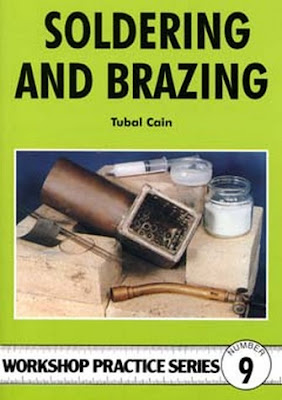With all the requisites for brazing to hand I thought that I had better make a trial attempt before having a go at the real thing, so I cleaned up a pair of nails that I found rolling around the shed.
The first attempt was a complete failure. I hadn't secured the two nails in place and, being round, every time I brought the brazing rod in they rolled apart, doh! On the second attempt, after wiring them together, I got a bond. But the distribution of the braze was not even across the two nails (the smaller had more) indicating that I hadn't got them both to the right temperature. This was confirmed when I took them to A More Experienced Man who promptly twisted them apart and said "that hasn't worked." However I thought I had got the hang of it, mostly.
The brazing process for the fireguard took another 3 sessions, each faster than the last. I learnt a few things on the way; that the workpiece had to be red hot; that if the flame was showing green tinges I had the brazing rod too close to the flame; that lots of flux was a good thing; and that it was best to heat along the thick rod and move the brazing rod in behind the torch flame. In then end I got the thing together even though some of the mesh wires got a bit distorted and some of the joints were, from my reading, far too far apart. Fortunately the fireguard isn't structural so my crappy joints won't be overtaxed and overall it doesn't look too bad.
 |
| Brazed and unbrazed workpieces |
 |
| Brazed and unbrazed workpieces |
Immediately after brazing I doused the hot workpiece under the hose and removed as much of the scale (ie flux) as possible with a wire scratch brush and a pair of pliers. I followed that up by grinding back any excess braze with a Dremel grinding stone and more brushing with a steel wire attachment on the Dremel to remove the last of the scale. Finally I used& emery cloth and wet & dry paper until I had everything smoothed out and any burnt paint sanded back. I gave the whole thing a white spirit wash and it was ready for painting.
I hummed and harred about which paint to use but in the end I settled for engine enamel because it has a gloss finish and the fireguard isn't likely to get massively hot (the enamel is OK up to 150oC). Two coats of that and job done.
 |
| Painted re-worked fireguard |
Refitting the brazed panels was straightforward and everything came together as planned. The overall cost was quite high, but 60% was for tools and of the remainder probably only £10-15 of consumables were actually used. Not too bad for a custom fit piece.
 |
| Re-assembled fireguard |
JOB DONE.
Time taken : A week (excluding delivery time)
Cost : £102.98 (including £59.62 for tools)









